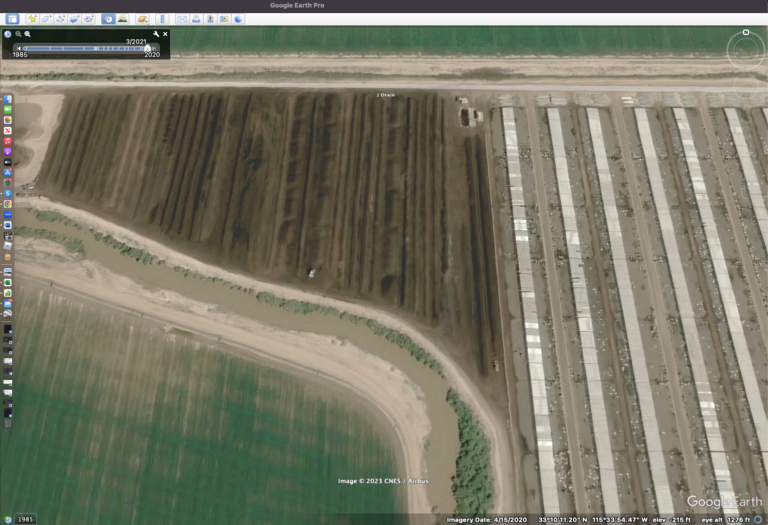Photo: The Brandt Cattle Company feedyard in Southern California’s Imperial Valley composts dry manure in an open field, a process that avoids nearly all methane production and emissions from the feedlot’s manure. Credit: Google Earth
A “kid gloves” approach to agricultural emissions, including burping cows, raises questions about an environmentally minded state’s commitment to combating climate change.
Forty miles north of the U.S.-Mexico border in Southern California’s Imperial Valley, the Brandt Company cattle ranch is the largest single point source of methane emissions in the state, releasing more of that greenhouse gas than any oil or gas well, refinery or landfill.
The 643-acre feedlot is home to 139,000 beef cattle, according to the most recent figures reported by state regulators. With their belching and manure, the animals produce an estimated 9,167 metric tons of methane annually, according to an Inside Climate News analysis. The calculations build on the work of the nonprofit coalition Climate TRACE, which is developing a farm-by-farm inventory of methane emissions from cattle with the aid of public records, satellite imagery and artificial intelligence.
In essence, the ranch’s emissions of methane, a greenhouse gas 81 times more potent than carbon dioxide over a 20-year period, equal the annual greenhouse gas emissions of 165,000 automobiles. Only Southern California Gas Company and Pacific Gas and Electric Company, the state’s largest two natural gas utilities—with leaks across tens of thousands of miles of underground pipeline networks—release more methane, the primary component of natural gas.
…cows collectively emitted more than twice as much methane from their belching and manure in 2020 as all of the country’s oil and gas wells…
But you won’t find the Brandt ranch, or any other single livestock operation or dairy, in state or federal greenhouse gas emissions databases.
The Environmental Protection Agency’s Greenhouse Gas Reporting Program, which was established in 2007 to provide a detailed accounting of emissions, site by site, from “all sectors of the U.S. economy,” exempts agriculture. A state reporting program that began in California in 2008 gives farmers a similar pass.
Methane’s potency as a greenhouse gas, combined with its short lifetime, means that curbing emissions of the gas is the single best way to combat climate change in the near term, according to the United Nations Intergovernmental Panel on Climate Change, or IPCC.
Nationwide, cows collectively emitted more than twice as much methane from their belching and manure in 2020 as all of the country’s oil and gas wells, including those active and abandoned, onshore and offshore, according to an Inside Climate News assessment of the EPA’s 2022 Inventory of U.S. Greenhouse Gas Emissions.
The shortage of government information about emissions from individual dairies and livestock operations presents a paradox. From one year to the next, California is increasingly threatened by […]
Full article: insideclimatenews.org

